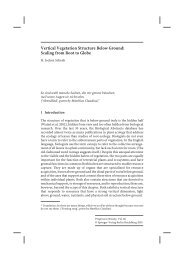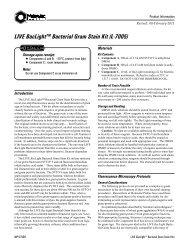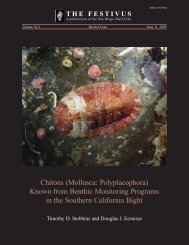Landscape Evolution at an Active Plate Margin - Biological Science ...
Landscape Evolution at an Active Plate Margin - Biological Science ...
Landscape Evolution at an Active Plate Margin - Biological Science ...
Create successful ePaper yourself
Turn your PDF publications into a flip-book with our unique Google optimized e-Paper software.
in 1922 the comp<strong>an</strong>ies were merged. Production continued<br />
until 1972 when a lawsuit pursued by the BLM<br />
found the original claims to be invalid.<br />
45.3 (0.4) Continue past the right (north) turnoff to<br />
Last Ch<strong>an</strong>ce C<strong>an</strong>yon. Once the main access into the<br />
El Paso Mountains, this road now requires 4WD since<br />
flash floods have re-engineered the road.<br />
47.7 (2.4) The site of Gypsite (south), oper<strong>at</strong>ed by<br />
Charles Koehn in 1909, produced gypsite (gypsum<br />
<strong>an</strong>d clay) used for plaster <strong>an</strong>d agricultural soil amendments<br />
(Hensher, 1998).<br />
49.1 (1.4) Cross the ch<strong>an</strong>nel of Red Rock C<strong>an</strong>yon<br />
Wash.<br />
49.6 (0.5) View of Honda test facility (see below).<br />
49.9 (0.3) Continue past C<strong>an</strong>til Road to the left.<br />
50.7 (0.8) Cross a drainage.<br />
53.0 (2.3) Neuralia Road is on the left just before we<br />
turn off on CA 14.<br />
Stop <strong>at</strong> the intersection with CA 14. Look to the<br />
south to see a curving line of veget<strong>at</strong>ion. This marks<br />
the edge of a 3-mile-wide oval (clearly seen in Goggle<br />
Earth imagery) test facility owned by Honda Motor<br />
Corpor<strong>at</strong>ion. The facility is well guarded <strong>an</strong>d<br />
off limits to travelers. At night, car headlights c<strong>an</strong><br />
often be seen as they circle the track. This has fueled<br />
conspiracy theories th<strong>at</strong> the test track is the locus<br />
of “alien” activity from the nearby “vortex” in the El<br />
Paso Mountains. TURN RIGHT (north) toward Red<br />
Rock C<strong>an</strong>yon St<strong>at</strong>e Park.<br />
55.4 (2.4) A trace of the El Paso fault is visible ahead<br />
to the left <strong>an</strong>d right. The t<strong>an</strong> sediments to the west<br />
contain a fossil fauna th<strong>at</strong> is signific<strong>an</strong>tly younger<br />
(l<strong>at</strong>e Hemphilli<strong>an</strong>) th<strong>an</strong> faunas in the Dove Spring<br />
form<strong>at</strong>ion. The sediments are bounded by the El Paso<br />
fault (north), the Sierra front fault (west) <strong>an</strong>d the Garlock<br />
fault (southeast) <strong>an</strong>d higher degree of clockwise<br />
rot<strong>at</strong>ion (35 degrees) th<strong>an</strong> the Dove Spring Form<strong>at</strong>ion<br />
(15 degrees; Whistler, 1991, p. 111). This suggests th<strong>at</strong><br />
the block has a history independent from the Dove<br />
Spring Form<strong>at</strong>ion, <strong>an</strong>d may have been left-l<strong>at</strong>erally<br />
tr<strong>an</strong>sl<strong>at</strong>ed from the Bedrock Spring Form<strong>at</strong>ion in the<br />
Lava Mountains (east of Hwy 395); a dist<strong>an</strong>ce of approxim<strong>at</strong>ely<br />
30 miles in the last 7–5 Ma.<br />
56.1 (0.7) Cross the trace of the El Paso fault, which<br />
here juxtaposes Mesozoic (Jurassic?) rocks <strong>an</strong>d undifferenti<strong>at</strong>ed<br />
Ricardo Miocene Group on its down-<br />
D. R. Jessey <strong>an</strong>d R. E. Reynolds<br />
thrown side (Whistler, 2005). Although motion along<br />
this fault has been characterized as predomin<strong>an</strong>tly<br />
dip-slip, its proximity to the Garlock fault suggests it<br />
may have a left-slip component. Despite paleoseismic<br />
studies on the nearby Garlock fault (McGill, 1992),<br />
little is known about slip r<strong>at</strong>es for the El Paso fault.<br />
The SCEDC website suggests last movement in the<br />
L<strong>at</strong>e Qu<strong>at</strong>ernary, but this presents a structural conundrum.<br />
The Garlock fault near this loc<strong>at</strong>ion has moved<br />
within the past 500 years, suggesting it is quite active.<br />
As such, its close proximity to the south-dipping El<br />
Paso fault should result in the Garlock fault buttressing<br />
dip slip movement along the El Paso fault. Perhaps<br />
Qu<strong>at</strong>ernary movement along the El Paso fault<br />
has been largely left-slip?<br />
56.8 (0.7) Basement rocks (largely gr<strong>an</strong>ite) are unconformably<br />
overlain by the Miocene Ricardo Group.<br />
This is best seen driving south on CA 14; when driving<br />
north, look back <strong>at</strong> the unconformity after passing<br />
a ridge of Mesozoic basement rock.<br />
57.4 (0.6) Move to left l<strong>an</strong>e <strong>an</strong>d prepare for a left turn.<br />
W<strong>at</strong>ch for oncoming traffic.<br />
57.6 (0.2) TURN LEFT (west) on Abbott Road to the<br />
Ricardo Campground <strong>an</strong>d Red Rock Park headquarters.<br />
58.5 (0.9) Note the basalt outcrop on the left side of<br />
the road.<br />
58.8 (0.3) Red Rock C<strong>an</strong>yon visitors center (El: 2175<br />
ft.). PARK on pavement before kiosk.<br />
STOP 1-2 (N 35°22’23.3”; W 117°59’18.3”). This<br />
outcrop (Fig. 1-5) lies within the west-dipping Dove<br />
Spring Form<strong>at</strong>ion of the Miocene Ricardo Group.<br />
Loomis (1984) divided the Dove Spring Form<strong>at</strong>ion<br />
Figure 1-5. Stop 2: outcrop of Miocene Dove Spring basalt exposed<br />
along Abbott Road. [D. R. Jessey photo]<br />
12 2009 Desert Symposium
















